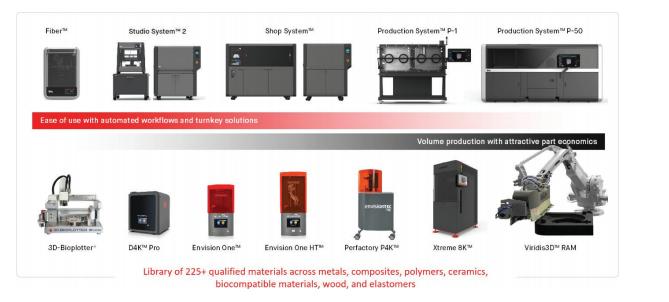The information in this proxy statement/prospectus is not complete and may be changed. Desktop Metal, Inc. may not sell the securities offered by this proxy statement/prospectus until the registration statement filed with the Securities and Exchange Commission is effective. This proxy statement/prospectus is not an offer to sell these securities and Desktop Metal, Inc. is not soliciting an offer to buy these securities in any jurisdiction where the offer or sale is not permitted.
PRELIMINARY — SUBJECT TO COMPLETION, DATED SEPTEMBER 15, 2021

Proxy Statement of |
| Prospectus of |
MERGER PROPOSED — YOUR VOTE IS VERY IMPORTANT
[·], 2021
Dear Fellow Stockholder:
We cordially invite you to attend a special meeting of stockholders of The ExOne Company, a Delaware corporation (“ExOne”), to be held on [·], 2021, at [·] Eastern time (the “special meeting”) in a virtual online format. As previously announced, on August 11, 2021, ExOne entered into a merger agreement (the “Merger Agreement”) providing for the combination of ExOne with Desktop Metal, Inc., a Delaware corporation (“Desktop Metal”). At the special meeting, you will be asked to consider and vote on a proposal to adopt the Merger Agreement and certain related matters. The Merger Agreement provides for a business combination in which Texas Merger Sub I, Inc., a Delaware corporation and wholly owned subsidiary of Desktop Metal (“Merger Sub I”), will merge with and into ExOne (the “First Merger”), with ExOne surviving as a wholly owned subsidiary of Desktop Metal, and (ii) immediately thereafter, ExOne, as the surviving corporation of the First Merger, will merge (such merger, the “Second Merger” and, together with the First Merger, the “Mergers”) with and into Texas Merger Sub II, LLC, a Delaware limited liability company and wholly owned subsidiary of Desktop Metal (“Merger Sub II”), with Merger Sub II surviving the Second Merger and continuing as a wholly owned subsidiary of Desktop Metal. A copy of the Merger Agreement is included as Annex A to the accompanying proxy statement/prospectus.
Under the Merger Agreement, at the effective time of the First Merger (the “Effective Time”) you will be entitled to receive for each share of ExOne common stock an amount equal to $8.50 in cash plus a number of shares of Desktop Metal Class A common stock equal to the exchange ratio set forth in the Merger Agreement (the “exchange ratio”), provided, however that such cash and stock merger consideration is subject to further adjustment as described in the accompanying proxy statement/prospectus. The exchange ratio depends on the average of the daily volume weighted averages of the trading price of Desktop Metal Class A common stock on the New York Stock Exchange (“NYSE”) on each of the 20 consecutive trading days ending on and including the trading day that is three trading days prior to the closing date (the “average stock price”). If the average stock price is greater than or equal to $9.70 per share, then the exchange ratio will be 1.7522. If the average stock price is less than $9.70 and greater than $7.94 per share, the initial exchange ratio of 1.9274 will be modified by multiplying such exchange ratio by the quotient of $8.82, divided by the average stock price. If the average stock price is less than or equal to $7.94, the exchange ratio will be 2.1416. The merger consideration will be subject to adjustment to ensure that (i) the stock consideration in the Mergers is not less than 45% of the total consideration in the Mergers, as determined for U.S. federal income tax purposes, and (ii) the number of shares of Desktop Metal Class A common stock to be issued in the Mergers does not exceed 19.9% of the issued and outstanding shares of Desktop Metal Class A common stock. Desktop Metal Class A common stock is traded on the NYSE under the trading symbol “DM” and we encourage you to obtain quotes for the Desktop Metal Class A common stock, given that part of the merger consideration is payable in shares of Desktop Metal Class A common stock.
The transaction cannot be completed unless ExOne stockholders holding at least a majority of the shares of ExOne common stock outstanding as of the close of business on [·], 2021, the record date for the special meeting, vote in favor of the adoption of the Merger Agreement at the special meeting.
Your vote is very important, regardless of the number of shares you own. The transaction cannot be completed unless the holders of at least a majority of the outstanding shares of ExOne common stock entitled to vote thereon vote to adopt the Merger Agreement. A failure to vote or an abstention will have the same effect as a vote “AGAINST” the adoption of the Merger Agreement.
Even if you plan to virtually attend the special meeting, ExOne requests that you complete, sign, date and return, as promptly as possible, the enclosed proxy card in the accompanying prepaid reply envelope or submit your proxy by telephone or via the Internet prior to the special meeting to ensure that your shares of ExOne common stock will be represented at the


